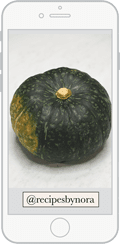Kabocha squash, with its sweet and creamy flesh, serves as an excellent alternative to kalabasa, a common ingredient in Filipino dishes. Let's explore this versatile ingredient and discover delicious ways to use it!

Jump to:
What is kabocha squash?
Kabocha squash, known as Japanese pumpkin, is a type of winter squash with a round or squat shape and bumpy, dark green skin. It belongs to the Cucurbitaceae family, along with other squash varieties, pumpkins, gourds, and melons.
It has a bright orange flesh that is sweet and nutty, often described as similar to chestnuts or sweet potatoes. Its texture is dense and creamy. It is not stringy or fibrous like other squash varieties.
Can kabocha be used in place of calabaza squash?

Yes! Calabaza squash (kalabasa in Filipino) is a winter squash with a milder flavor and a more fibrous, stringy flesh. Its skin is green to light tan or orange with bright yellow or orange flesh.
It is commonly used in Filipino cuisine, though harder to find in the US. Kabocha squash makes an excellent substitute.

Is kabocha squash healthy?
According to the Harvard T.H. Chan School of Public Health, kabocha squash is a nutritious choice. It is low in calories and rich in fiber, which supports digestive health, regulates blood sugar levels, and lowers cholesterol.
The squash is high in vitamins A and C, essential for immune function, skin health, and eye health. Its potassium content supports heart health and blood pressure regulation, while also providing calcium and magnesium to promote strong bones.
WebMD notes that one of its health-promoting compounds is flavonoids, such as beta-carotene and lutein, known for their antioxidant and anti-inflammatory properties. Research suggests that these compounds may lower the risk of chronic conditions like heart disease, cancer, and neurodegenerative disorders.
As with any dietary changes or adding new foods to your diet, it's crucial to consider individual health circumstances. Seeking guidance from a healthcare professional ensures safe and beneficial consumption.
Can you eat the skin of kabocha squash?
Yes! Unlike other types of winter squash, its skin is relatively thin and can be eaten along with the flesh. The skin contains nutrients and adds a bit of texture to your dish.
However, it can be tough and fibrous in some areas, particularly near the stem or base of the squash. If you prefer a softer texture or for soups, peel the skin off with a vegetable peeler or a sharp knife before cooking.

How to buy
Kabocha squash is available at Asian grocery stores, farmers' markets (during fall and winter months), health food stores, and some well-stocked supermarkets.
Look for a hard, dark green rind with no blemishes or bruises. It should feel heavy for its size, indicating that it is dense and has a good amount of flesh. The stem should be firmly attached.
How to store
Kabocha squash can be stored for up to a month in a cool, dry place away from direct sunlight and heat. Once cut, remove the seeds and cover the squash tightly with plastic wrap. It can last up to a week in the fridge.
Keep it away from ethylene-producing fruits and vegetables, like bananas and apples, and check regularly for spoilage.

How to prepare
Wash the squash thoroughly to remove any dirt or debris. As an option, you can microwave it for 3 to 5 minutes to soften the rind and make cutting easier.
Step 1: Place it on a cutting board and make a small cut on the top using a sharp knife, slightly off center to avoid the stem. Carefully cut through the squash along the previously made cut.
Step 2: Using a spoon, remove the seeds and fibrous flesh from the center of each half.

Step 3: Place each half with its flesh side flat on the cutting board, then cut it in half lengthwise from top to bottom.
Step 4: Slice off the stem and peel it at this point if you prefer.

Step 5: Cut each quarter into 3-4 wedges.

Step 6: You can cut them into bite-size pieces or into matchsticks, depending on your recipe. Kabocha, like calabaza squash, can be used in stews, soups, and sautés.

Roasting kabocha squash may not be common in Filipino cuisine, but it sure is an easy way to prepare it.

Filipino recipes with kabocha squash
Kabocha squash can be used similarly to calabaza squash in Filipino cooking. Here are some ways:
- Ginataang Kalabasa: Squash cooked in coconut milk along with shrimp, crab, or pork. Some variations may include vegetables like yardlong beans or malunggay (moringa).
- Ukoy: These shrimp and vegetable fritters consist of shredded squash, shrimp, and other vegetables, served with a spiced vinegar dipping sauce.
- Pinakbet: A hearty stew made with a variety of local vegetables (okra, eggplant, yardlong beans, bitter melon, and squash) with sautéed shrimp paste, aromatics, and proteins like shrimp or pork.
- Lumpiang Gulay: Fried vegetable spring rolls with shredded squash and other vegetables or ground meat, rolled in thin lumpia wrappers.
- Kalabasa Soup: A soup that can be made with kabocha or calabaza variety. One version is puréed with aromatics and sometimes coconut milk, while another includes diced squash with other vegetables in a thin broth.
Other ingredient guides you may like

Did you like this post? I would love to know! Your feedback helps me make better recipes. Please rate, review, or comment below. Questions about this post are welcome, too!
Let's connect on Facebook, Instagram, Pinterest, TikTok, Twitter, and Youtube. Be sure to tag me when you try any of my recipes @recipesbynora!











Laura
I love making pinakbet and i’ve never used the real calabaza. Kabocha always works great for me. Thanks for this post!
Nora Rey
That's awesome! Pinakbet is such a delicious and healthy dish. It's great to hear that you've been able to make it work with kabocha squash, which is a great alternative to calabaza. I do the same, too.